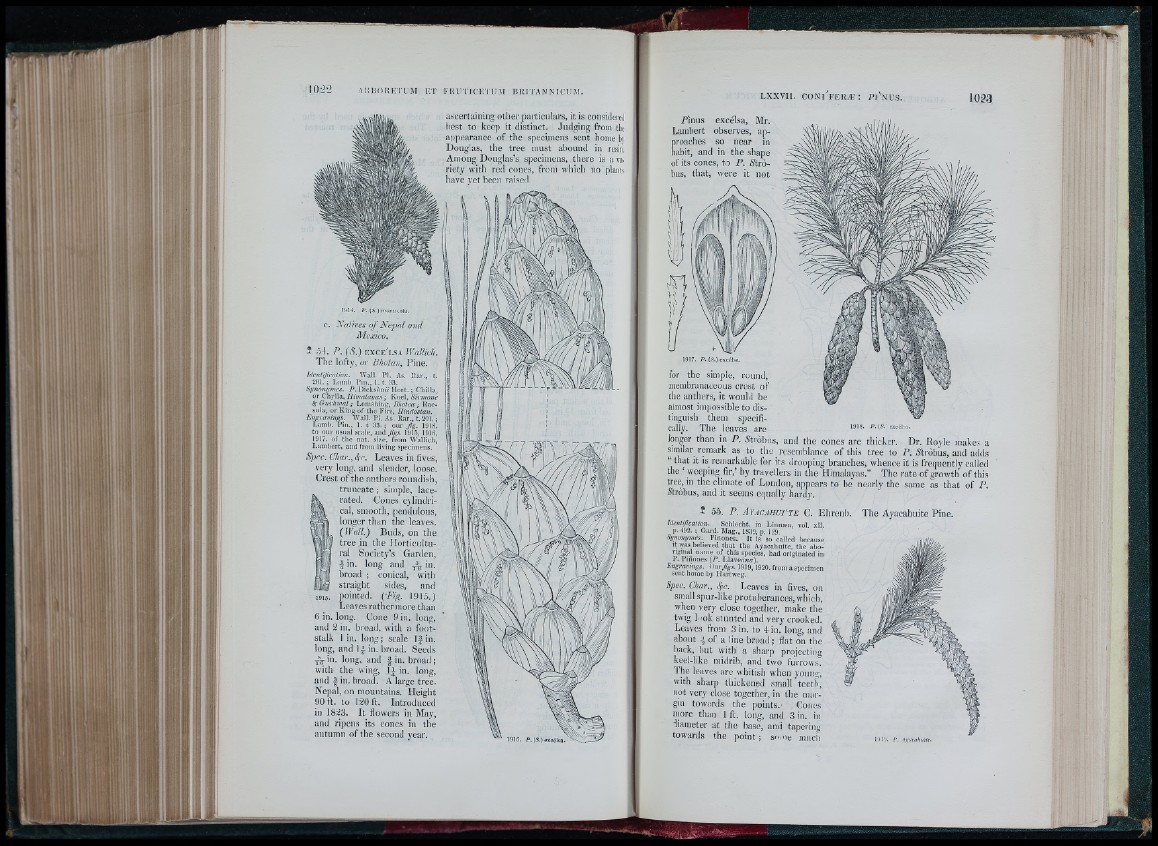
ascertaining other particulars, it is considered
best to keep it distinct. Judging from tiie
aiipearance of the specimens sent home bv
Douglas, the tree must abound in resin,
Among Douglas’s specimens, there is a variety
with red cones, fi'om w'hich no plant.s
imve yet been raised
IHl'i. i*. (S.) rroiHuoln.
c. Na/ives of Nepal and
Mexico.
f 5 4 . P . ( S . ) e x c f / l s a IV am c h .
lofty, or Bhotan, Pine.
IrtenVJication. Wall. Pl. A.s. P ar., t.
201. ; Lamb. Pin., 1. t. 33.
Hynoiii/mcs. P . l)icks<5n?7 H o r t.; Cbilhu
or Chylla, Hmialayas ¡ Kuel, Sirmone
6; Gurkmal; Lenishiicp, Bhotea; llac-
sula, or King of the Firs, Hindostán.
Engravings. Wail. Pl, As. lia r., t.2 0 l.;
Lamb. Pin., 1. t 33.; our Jig. 1!)18.
to our usual scale, and figs. 1915, iOlfi,
1917. of th e nat. size, from Wallich,
Lambert, and from living specimens.
Spec. Char., Leaves in fives,
very long, and slender, loose.
Crest of the anthers roundish,
truncate ; simple, lacerated.
Cones cy lindrical,
smooth, pendulous,
longer than the leaves.
(Wall.) Buds, on the
tree in the ITorticuItu-
ral Society’s Gartlen,
L in. long and
broad ; conical, with
straight sides, and
pointed. {■Fig. 1915.)
Lcaves rathermore than
6 in. long. Cone 9 in. long,
and 2 in. broad, with a footstalk
iin. long; scale Ifin .
long, and I f in. broad. Seeds
yVin. long, and fin. broad;
with the wing, If in. long,
and I in. broad. A large tree.
Nepal, on mountains. Height
90 ft. to 1 2 0 ft. Introduced
in 1823. It flower.s in May,
and ripens its cones in the
autumn of the second year.
1 0 2 3
jpinus excelsa, Mr.
Lambert observes, approaches
so near in
habit, and in the shape
of its cones, to P. ¿tro-
biis, that, were it not
for the simple, round,
membranaceous crest of
the anthers, it would be
almost impossible to distinguish
them specifically.
The leaves are (‘‘''■>-<'¿1"-
longer than in P. ¿tióbns, and the cones are thicker. Dr. Hoyle makes a
similar remark as to the resemblance of this tree to P. ¿tróbiis, and adds
“ that it is remarkable for its drooping branches, whence it is frequently called
the ‘ weeping fir,’ by travellers in the Himalayas.” The rate of growth of this
tree, in the climate of London, appears to be nearly the same as that of P.
¿trobus, and it seems equally hardy.
Í 55. P. A y a c a h u P t e C. Ehrenb. The Ayacahuite Pine.
Identificaiion. Schlecht. in IJn n « a , vol. xii.
p. 492, ; Gard. Mag., 1839, p. 129.
Synonymes. Piñones. It is so called because
it was believed that the Ayacahuite, the abo-
rigmal name of this species, had originated in
P. P iflo n e s (P . Llavermrt).
Engravings. O u r/g s . 1919, 1920. from aspecimen
sent home by Hartweg.
Spec. Char., c^c. Leaves in fives, on
small spur-like protuberances, whicli,
when very close together, make the
twig luok stunted and very crooked.
Leaves from 3 in. to 4 in. long, and
about f of a line broad ; flat on tbe
back, but with a sharp projecting
keel-like midrib, and two furrow.s.
The leaves are whitish when young,
wdth sharp thickened small teeth,
not very close togetiier, in the margin
towards the points. Cones
more than 1 ft. long, and 3 in. in
liameter at the base, and tapering
towards the point ; síluc much
i. ' te